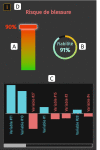Relationship between a daily injury risk estimation feedback (I-REF) based on machine learning techniques and actual injury risk in athletics (track and field): protocol for a prospective cohort study over an athletics season
- PMID: 37192797
- PMCID: PMC10193054
- DOI: 10.1136/bmjopen-2022-069423
Relationship between a daily injury risk estimation feedback (I-REF) based on machine learning techniques and actual injury risk in athletics (track and field): protocol for a prospective cohort study over an athletics season
Abstract
Introduction: Two-thirds of athletes (65%) have at least one injury complaint leading to participation restriction (ICPR) in athletics (track and field) during one season. The emerging practice of medicine and public health supported by electronic processes and communication in sports medicine represents an opportunity for developing new injury risk reduction strategies. Modelling and predicting the risk of injury in real-time through artificial intelligence using machine learning techniques might represent an innovative injury risk reduction strategy. Thus, the primary aim of this study will be to analyse the relationship between the level of Injury Risk Estimation Feedback (I-REF) use (average score of athletes' self-declared level of I-REF consideration for their athletics activity) and the ICPR burden during an athletics season.
Method and analysis: We will conduct a prospective cohort study, called Injury Prediction with Artificial Intelligence (IPredict-AI), over one 38-week athletics season (from September 2022 to July 2023) involving competitive athletics athletes licensed with the French Federation of Athletics. All athletes will be asked to complete daily questionnaires on their athletics activity, their psychological state, their sleep, the level of I-REF use and any ICPR. I-REF will present a daily estimation of the ICPR risk ranging from 0% (no risk for injury) to 100% (maximal risk for injury) for the following day. All athletes will be free to see I-REF and to adapt their athletics activity according to I-REF. The primary outcome will be the ICPR burden over the follow-up (over an athletics season), defined as the number of days lost from training and/or competition due to ICPR per 1000 hours of athletics activity. The relationship between ICPR burden and the level of I-REF use will be explored by using linear regression models.
Ethics and dissemination: This prospective cohort study was reviewed and approved by the Saint-Etienne University Hospital Ethical Committee (Institutional Review Board: IORG0007394, IRBN1062022/CHUSTE). Results of the study will be disseminated in peer-reviewed journals and in international scientific congresses, as well as to the included participants.
Keywords: EPIDEMIOLOGY; PUBLIC HEALTH; SPORTS MEDICINE.
© Author(s) (or their employer(s)) 2023. Re-use permitted under CC BY-NC. No commercial re-use. See rights and permissions. Published by BMJ.
Conflict of interest statement
Competing interests: None declared.
Figures


References
-
- Edouard P, Morel N, Serra J-M, et al. . Prévention des lésions de l’appareil locomoteur liées à la pratique de l’athlétisme sur piste. revue des données épidémiologiques. Science & Sports 2011;26:307–15. 10.1016/j.scispo.2011.04.003 - DOI
-
- Edouard P, Alonso JM, Jacobsson J, et al. . Injury prevention in athletics: The race has started and we are on track. New Stud Athl 2015:69–78. 10.1136/bjsports-2019-101969 - DOI
-
- Edouard P, Navarro L, Branco P, et al. . Injury frequency and characteristics (location, type, cause and severity) differed significantly among athletics (‘track and field’) disciplines during 14 international championships (2007–2018): implications for medical service planning. Br J Sports Med 2020;54:159–67. 10.1136/bjsports-2019-100717 - DOI - PubMed
-
- Edouard P, Alonso JM. Epidemiology of track and field injuries. New Studies in Athletics 2013;28:85–92. 10.1136/bjsports-2014-094322 - DOI
Publication types
MeSH terms
LinkOut - more resources
Full Text Sources
Medical
